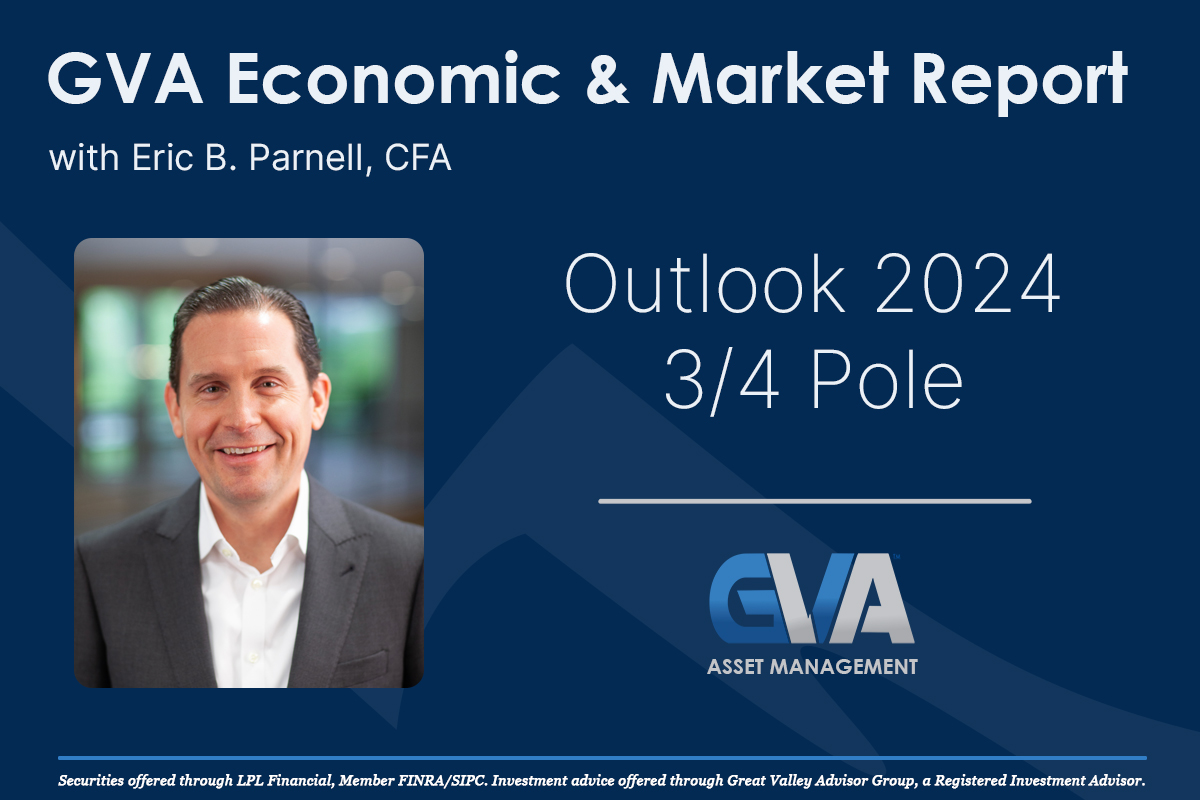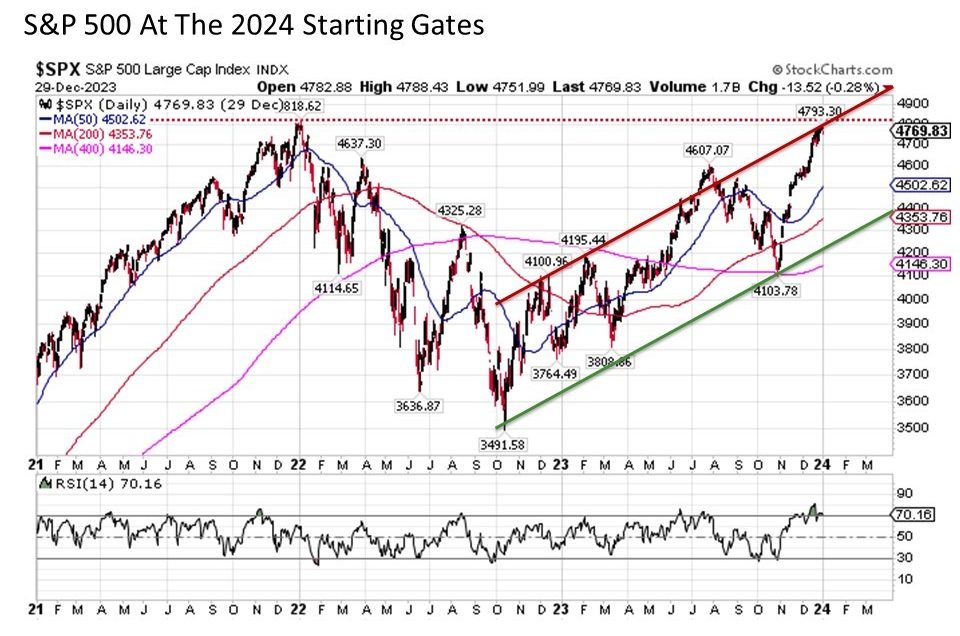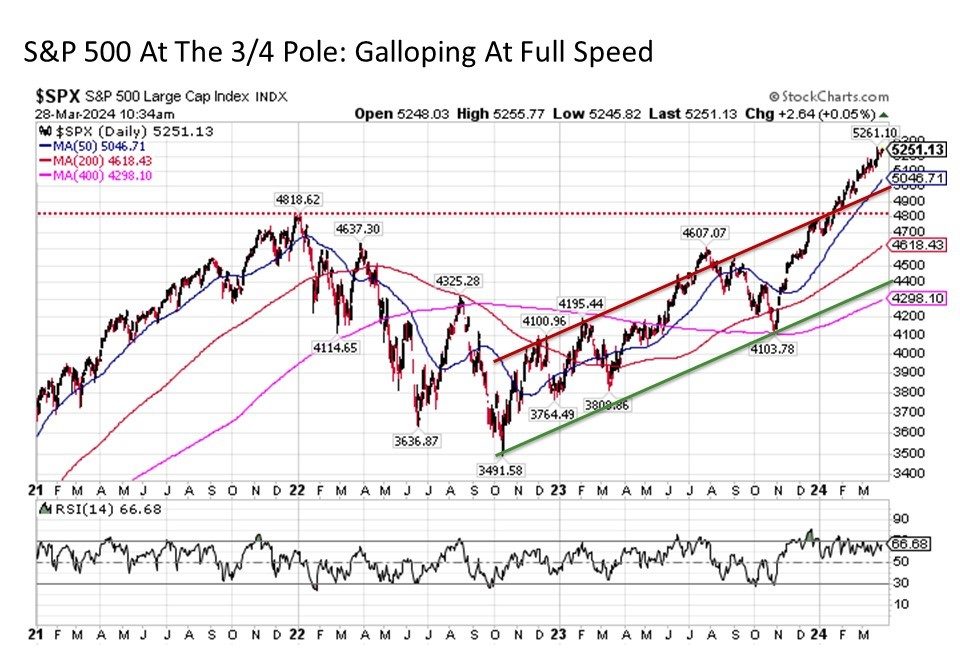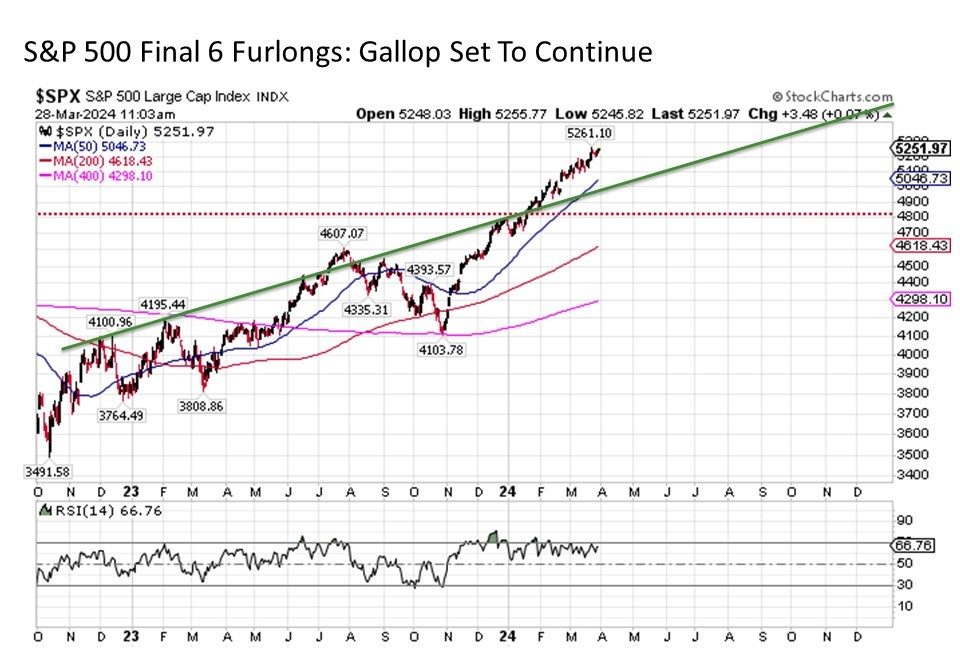
Hard to believe the first quarter of 2024 is drawing to a close. As we pass the 3/4 pole in our 8 furlong race through the calendar year, it is worthwhile to assess the key market events that are now behind us and what lies ahead in the horse race to the year-end finish line.
Starting gates. A key market theme at the starting gates was that the U.S. stock market was due for some sort of consolidation. In the final two months of 2023, the S&P 500 following an August to October pullback that shaved -11% staged a furious +17% rally in the final two months of the year. This sent the headline index towards three challenging junctures from a technical analysis perspective.

Not only was the S&P 500 heavily overbought with a Relative Strength Index (RSI) reading well over 70, but the market had also returned to the top of its trading channel dating back to the October 2022 lows. At the same time, the benchmark index surged all the way back to its previous all-time highs set two years ago in January 2022 before the onset of the inflation fueled bear market. Why does this last point matter? Because selling pressure increasingly sets in among those investors that flooded into the market at the previous all-time highs subsequently spent the last two years waiting to get back to breakeven to get their initial investment back. Add to all of these technical forces the fundamental reality that stocks were historically overvalued and the economy was bracing for a potential recession in 2024, and the stage was set for stocks to start the year at a walk or trot at best.
3/4 Pole. The various forces pulling up the reins at the start of the year has made the galloping pace of the market all the more striking. Stocks barely paused for a few trading days to open the year before breaking out to the upside above its various resistance levels.

Put simply, stocks are off to the races in the first 8 furlongs of 2024. This has changed the complexion of what we should reasonably expect for the upcoming second quarter and the remainder of the year. From a fundamental perspective, expectations for an recession have faded to zero, as economic growth projections remain solidly robust and the latest stream of data releases are repeatedly coming in hotter than expected. As a result, arguably for the first time since before the Great Financial Crisis more than 15 years ago, the stock market is moving higher not on hopes and expectations for the next round of monetary policy easing from the U.S. Federal Reserve but instead on an economy that is bursting with growth at the same time that inflationary pressures continue to abate.
As a result, an S&P 500 that initially was projected heading into the year to have the potential to crest the 5200 mark under more favorable scenarios by the end of the second quarter has ended up passing this mark before the end of the first quarter. At the same time U.S. mid-caps as measured by the S&P 400 Index have also surged to new all-time highs with U.S. small caps as measured by the S&P 600 and developed international stocks as measured by the MSCI EAFE Index also on the brink of fresh new bests.
Final 6 furlongs. With the resoundingly brisk start to the year, what can we reasonably expect for the rest of the race?
Expect the pace to remain strong for the foreseeable future. With the strong upside breakout in the first quarter, the S&P 500 is now tracking a pace to end 2024 with support in the 5400 to 5600 range. While a upper bound to the new trading range has not yet been set – the next still overdue pullback in stocks will help set the bar – an S&P 500 stretching toward the 6000 range is no longer entirely out of the conversation. We will learn much more in this regard over the next quarter mile of the race.

Of course, we are still early in the year, and much can happen from an economic, financial, political, and geopolitical perspective that has the potential to upend the market for extended periods along the way.
To begin, the economic data remains sufficiently strong. Although both readings have faded somewhat in recent weeks and have the potential to fade further as we continue through the rest of the year, estimates for 2024 Q1 GDP growth remain solidly in the +2% range, which is hardly the signs of an oncoming recession. Moreover, such economic growth is supporting forecasts for double-digit corporate earnings growth through the remainder of 2024. If the economy holds strong and corporations deliver on earnings, stocks can continue to advance to the upside despite historically rich valuations.
But what if the economy starts to disappoint and we fall into recession, dragging corporate earnings expectations to the downside with it? Then a reverse boomerang effect starts in support of the market. When we entered the starting gates for 2024, investors were expecting the Fed cut interest rates by a quarter point as many as seven times this year. This expectation was a primary reason why stocks surged +17% from their October lows and the 10-Year U.S. Treasury yield fell dramatically (and prices soared) from effectively 5.0% in October to below 3.8% by the end of the year. Over the last three months, expectations for Fed rate cuts have fallen sharply to a base case of two to three quarter point reductions with a growing chorus of prognosticators suggesting that we might not get any rate cuts at all in 2024. Markets have taken this dramatic downside shift in Fed rate cut expectations in full gait. Now, if the economy ends up slowing, the market will anticipate more rate cuts than currently expected, and investors will likely love it the same way they have for the years since the Great Financial Crisis first conditioned this investor response mechanism.
Amid this good news is good news and bad news is good news state of the market, it will likely take an exogenous shock to unsettle the market in the coming months. What are some of the scenarios?
First, a geopolitical event no matter how extreme is not likely to cause anything more than a temporary pullback in stock prices. Why? Because no matter how dramatic and unexpected the event might be, the fiscal and monetary policy makers will almost respond with “whatever it takes” to maintain stability in the U.S. and global financial system. We have to look no further to how the markets responded in the aftermath of COVID that effectively shutdown the entire global economy for an extended stretch and the 9/11 attacks at the turn of the millennium to see how quickly markets can bounce back even under the most dire circumstances. So even if Russia were to invade a NATO country, China were to invade Taiwan, another wave of U.S. bank failures erupted, or any various known unknown scenarios, the markets might lurch lower initially, only to subsequently rebound once the inevitable policy response takes hold.
Instead, the real and sustained downside risk for the markets in the months ahead comes from a key primary source. This is liquidity. As long as liquidity is flowing freely into capital markets, the path for stocks (and bonds, and gold . . .) is higher. But if events arise that threaten to disrupt these liquidity flows, then the potential downside for stocks could suddenly have a 2022 feel to them.
The leading risk in this regard is a renewed rise in inflation. Inflation has been steadily fading since its 2022 peaks. But the risk remains that a stronger than expected economy and/or extended supply chain disruptions from an unexpected geopolitical event could plant the seeds for a renewed sustained surge in inflation. If such an event were to come to pass, this has the potential to put a full stop to the 2024 stock market horse race and send stocks breaking resistance to the downside. But the good news is at the present time, inflation readings continue to trend on the disinflationary side and liquidity remains abundant as evidenced by a variety of signals including the price of Bitcoin surging to new all-time highs and the latest wave of Special Purpose Acquisition Company (SPAC) and meme stock surges (the latest example being a recently widely discussed SPAC with $3.3 million in revenues against $49 million in losses boasting an $8 billion market cap – such is the signs of abundant liquidity and speculative fervor regardless of one’s political views). As long as inflation continues to trend lower, or even if it simply levels out, we should continue to expect the liquidity environment to remain supportive for continued speculative activity and upside in risk asset prices.
Bottom line. Stocks are off to a blazing gait so far in the 2024 horse race. And while periods of short-term downside should not only be expected but are arguably overdue at this point, the broader direction for stock prices remains higher as we enter the remaining 6 furlongs of the year.
Disclosure: I/we have no stock, option or similar derivative position in any of the companies mentioned, and no plans to initiate any such positions within the next 72 hours. I wrote this article myself, and it expresses my own opinions. I am not receiving compensation for it. I have no business relationship with any company whose stock is mentioned in this article. Investment advice offered through Great Valley Advisor Group (GVA), a Registered Investment Advisor. I am solely an investment advisor representative of Great Valley Advisor Group, and not affiliated with LPL Financial. Any opinions or views expressed by me are not those of LPL Financial. This is not intended to be used as tax or legal advice. All performance referenced is historical and is no guarantee of future results. All indices are unmanaged and may not be invested into directly. Please consult a tax or legal professional for specific information and advice.
Compliance Tracking #: 559850-1
